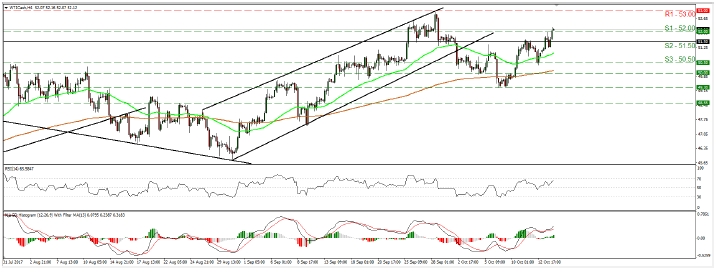- The greenback tumbled on Friday, after the US inflation prints for September fell short of meeting market expectations. The headline CPI rate rose by less than anticipated, while the core rate remained unchanged for the 5th consecutive month, missing the forecast for an uptick. Despite these disappointments though, the implied probability for a Fed rate hike in December remained elevated at 82% according to the Fed fund futures, while the dollar managed to recover most of its CPI-related losses before markets closed on Friday.
- With regards to US indicators, there is nothing major on the agenda this week. As such, we think that the dollar’s short-term direction may depend on 2 key factors: the likelihood for meaningful tax reform, as well as hints around who the next Fed Chair will be. With regards to the former, tax overhaul has begun to attract an increasing amount of attention, with the Senate expected to vote on a budget resolution this week that could accelerate tax reform. As for the next Fed chief, President Trump is anticipated to announce his choice soon, perhaps as early as this week or the next. Betting markets (predictit.org) seem to favor Fed Board Governor Jerome Powell for the position, with the second most likely candidate being Kevin Warsh, a critic of the Fed’s QE purchases and someone who is seen as more hawkish than Powell on policy.
- EUR/USD spiked up on Friday following the lower-than-expected US CPI rates. Nevertheless, the pair hit resistance at the crossroads of the 1.1880 (R1) level and the downside resistance line drawn from the peak of the 8th of September. Then, it slid to give back all its CPI-related gains and to trade even lower. It fell back below the 1.1830 (R1) key barrier, which shifts the bias back to cautiously negative in our view. At the time of writing, the rate looks to be headed for a test near the 1.1790 (S1) support line, where a decisive dip may initially target our next hurdle of 1.1755 (S2).
Oil spikes up as Iraqi forces advance towards Kurdish oil fields
- On Sunday, the Iraqi army advanced towards Kirkuk, an oil-rich city that is controlled by the Iraqi Kurds, who recently declared their independence. Even though there have been no reports of actual fighting so far, oil prices still spiked higher on the news, perhaps due to the renewed risk of supply disruptions in the region.
- WTI edged north during the Asian morning Monday, to break above the resistance (now turned into support) obstacle of 52.00 (S1). Our view is that the price is likely to continue trading higher for a while and perhaps challenge the 53.00 (R1) hurdle, marked by the peak of the 28th of September. Having said that though, we still remain skeptical on the establishment of a healthy long-term uptrend. The black gold is trading within the sideways range between 51.50 (S2) and 55.30 (R3), where we believe that US shale producers are attracted to increase production, thereby putting a lid on any short-term gains in oil prices.
Today’s highlights:
- The economic calendar is almost empty today. We only get the US Empire State manufacturing index for October.
- We have one speaker on the schedule: ECB Executive Board member Sabine Lautenschlager.
As for the rest of the week:
- On Tuesday, the minutes of the RBA’s October meeting and New Zealand’s CPI for Q3 are due out. We also get the UK CPI data for September while on Wednesday, we get the nation’s employment and wage growth prints for August. On Thursday, we get China’s economic growth data for Q3, as well as Australia’s unemployment rate and UK retail sales, both for September. Finally on Friday, Canada’s CPI prints for September are coming out.
EUR/USD
Support: 1.1790 (S1), 1.1755 (S2), 1.1720 (S3)
Resistance: 1.1830 (R1), 1.1880 (R2), 1.1940 (R3)
WTI
Support: 52.00 (S1), 51.50 (S2), 50.50 (S3)
Resistance: 53.00 (R1), 54.00 (R2), 55.30 (R3)


